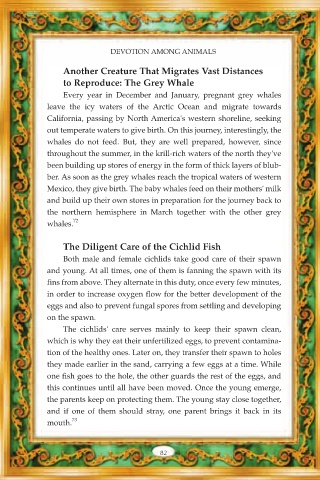Page 84 - Devotion Among Animals Revealing the Work of God
P. 84
DEVOTION AMONG ANIMALS
Another Creature That Migrates Vast Distances
to Reproduce: The Grey Whale
Every year in December and January, pregnant grey whales
leave the icy waters of the Arctic Ocean and migrate towards
California, passing by North America's western shoreline, seeking
out temperate waters to give birth. On this journey, interestingly, the
whales do not feed. But, they are well prepared, however, since
throughout the summer, in the krill-rich waters of the north they've
been building up stores of energy in the form of thick layers of blub-
ber. As soon as the grey whales reach the tropical waters of western
Mexico, they give birth. The baby whales feed on their mothers' milk
and build up their own stores in preparation for the journey back to
the northern hemisphere in March together with the other grey
72
whales.
The Diligent Care of the Cichlid Fish
Both male and female cichlids take good care of their spawn
and young. At all times, one of them is fanning the spawn with its
fins from above. They alternate in this duty, once every few minutes,
in order to increase oxygen flow for the better development of the
eggs and also to prevent fungal spores from settling and developing
on the spawn.
The cichlids' care serves mainly to keep their spawn clean,
which is why they eat their unfertilized eggs, to prevent contamina-
tion of the healthy ones. Later on, they transfer their spawn to holes
they made earlier in the sand, carrying a few eggs at a time. While
one fish goes to the hole, the other guards the rest of the eggs, and
this continues until all have been moved. Once the young emerge,
the parents keep on protecting them. The young stay close together,
and if one of them should stray, one parent brings it back in its
mouth. 73
82

